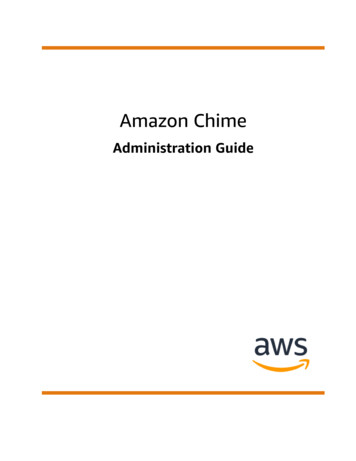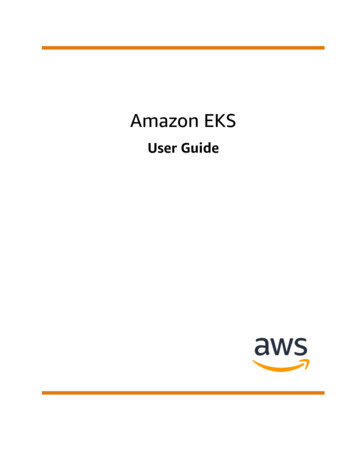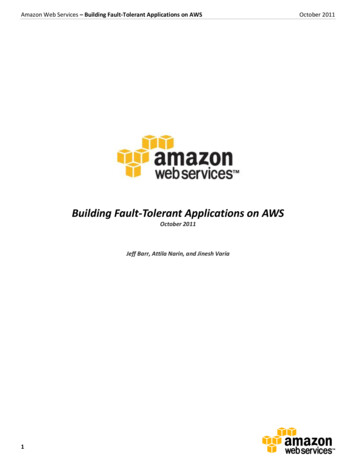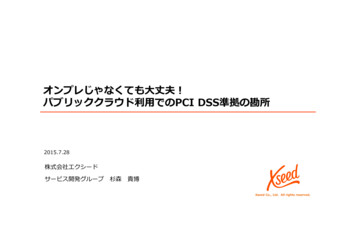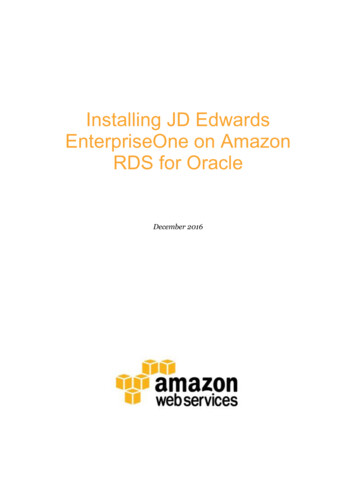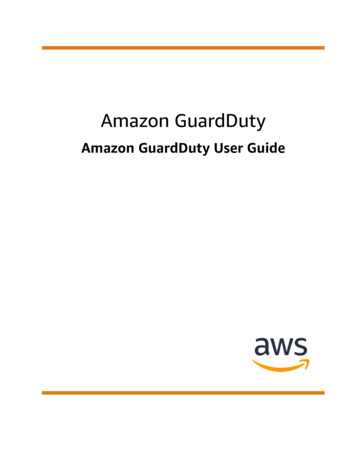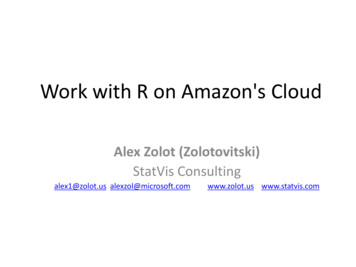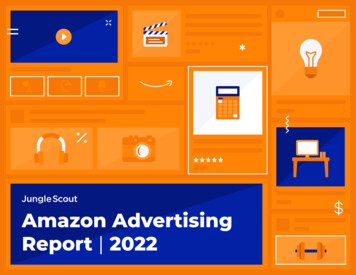
Transcription
Amazon Advertisng Report 2022 1
Table of ContentsCh. 1Ch. 2The Rise and Size of Amazon Advertising / 3Ch. 5Challenges, Strategies & Predictions / 26 The Importance of Advertising on Amazon Advertising & The Supply Chain How Big is Amazon’s Advertising Business? Concern Over Rising PPC Costs Advertising Product Usage Among Brands and Sellers How Agencies Support Advertising Strategy Consumers’ Advertising Awareness and Preferences Predicting New Ad ProductsAmazon Advertising Spend / 13Ch. 6About the Report / 33 Spend by Marketplace Methodology Spend by Ad Product Using the Data Spend by Ad Targeting Type About Jungle Scout Spend by Product PriceCh. 3Ch. 7Return on Ad Spend (RoAS) / 18 Effective Advertising on Amazon: Measuring RoAS RoAS by Ad ProductsDigital Advertising Glossary / 34 Definitions and descriptions for common Amazonadvertising terms About Downstream RoAS by Targeting Type RoAS by Product Price RoAS by Bidding StrategyCh. 4Category Leaderboard (U.S.) / 22 Investing Wisely: How Spend & RoAS Vary by Product Category Spend by Product Category RoAS by Product CategoryAmazon Advertisng Report 2022 2
Chapter 1The Rise and Size of Amazon AdvertisingThe rapid growth of Amazon’s digital advertising business has2021 Advertising revenue by companyincreasingly captured industry attention, and it’s not difficult to see why.In February 2022, Amazon reported standalone revenue from advertisingservices for the first time. Reaching 31.2 billion in sales for full-year 2021,the business segment became the third-largest in the world after Googleand Facebook.Complementing this growth, Amazon has continued to expand thecapabilities — and roll out entirely new forms — of its advertisingproducts while attracting an increasing number of brands, agencies andthird-party sellers to its platform.1Alphabet 2021 Form 10-K, 2Meta 2021 Form 10-K, 3Amazon 2021 Form 10-K, 4Walmart Q4Fiscal Year 2022 earnings release, 5eBay 2021 Form 10-KAmazon Advertisng Report 2022 3
01. THE RISE AND SIZE OF AMAZON ADVERTISINGThe Importance of Advertising on AmazonWhile consumers have increasingly warmed to ecommerce over the past decade, the move to online shopping accelerated rapidly at the onset of the COVID-19pandemic in 2020 and showed continued growth over the past two years. And while spending trends began to shift in the first few months of the year alongsiderising concerns about inflation and broader economic conditions, consumers still overwhelmingly turn to Amazon for online shopping; the company reportedyear-over-year net sales growth of 7% for the first quarter of 2022.1Consumers start their online shopping searches on AmazonWhen shopping online, the majority of consumers (63%) start their search on Amazon. While that figure is slightly lower compared to a year prior (74%) as otherecommerce platforms work to expand their footprints, Amazon’s power is still evident compared to other options such as Google and other search engines,other ecommerce platforms, and social media.Where do consumers begin their search when shopping online?INSIGHTSWhen searching the internet forproducts, most consumers starton Amazon.Social media channels likeFacebook, YouTube, and Instagramplay important roles in consumers’online product searches.1Amazon first-quarter 2022 earnings releaseAmazon Advertisng Report 2022 4
01. THE RISE AND SIZE OF AMAZON ADVERTISINGKey differentiators: Shopper targeting and detailed sales attributionBeyond the company’s broad reach and market dominance, Amazon’sMarketing Funneladvertising services provide brands and sellers with unique benefits thatset it apart from competitors. The ability to report direct sales attribution— a metric that gives more detailed insight than the overall impressionsand clicks offered by platforms such as Google or Facebook — continuesto appeal to online marketers. Among the most significant reasons thecompany continues to attract marketers are:Audience of ready-to-buy shoppers: Amazon occupiesa unique position at the end of the marketing funnel.Advertisers using Amazon have the ability to reach customersat the point of purchase.Right product, right person: It’s not just about timing,it’s about showing the right products to the rightpeople. Amazon’s wealth of shopper data allows brandsand marketers to expand their reach across channels(display, audio, and over-the-top video) with contextuallyappropriate ads.Measuring performance: Amazon’s attribution is a keydifferentiator between search marketing on Amazonversus all other search marketing platforms. Attributiontells advertisers which specific ads are driving sales. It’salso a key piece of the formula to determine return on adspend (RoAS), or how much revenue is produced from anadvertising investment.Amazon Advertisng Report 2022 5
01. THE RISE AND SIZE OF AMAZON ADVERTISINGHow Big is Amazon’s Advertising Business?After recording double-digit quarter-over-quarter growth in advertising sales for six consecutivequarters, Amazon began reporting standalone revenue related to its advertising services businesssegment for the first time in February 2022. In 2021, the segment generated 31.2 billion in revenue,up from 19.8 billion in 2020 (a 58% increase) and 12.6 billion in 2019 (a 147% increase). With sustainedgrowth, Amazon’s advertising business is increasingly being viewed as more of a competitor to those oftech giants Google and Facebook than to those of its ecommerce competitors.Annual advertising services* revenueINSIGHTSSource: Amazon.com, Inc. 2021 10-KQuarterly advertising services revenueRevenue from Amazon’sadvertising services businesssegment represented 6.6% ofAmazon’s total net sales in 2021,up from 4.5% in 2019Source: Amazon Q4’21 and Q1’22 earnings reports*Includes sales of advertising services to sellers,vendors, publishers, authors, and others, throughprograms such as sponsored ads, display, andvideo advertising.Amazon Advertisng Report 2022 6
01. THE RISE AND SIZE OF AMAZON ADVERTISINGVHistorical and projected U.S. digital ad revenue share by company*Note: includes advertising that appears on desktop and laptop computers as well as mobile phones, tablets, and other internet-connected devices, and includes all the various formats ofadvertising on those platforms; net ad revenues after companies pay traffic accquisition costs (TAC) to partner sites; Google includes YouTube advertising revenues; Facebook includes Instagramadvertising revenues*Data and projections via eMarketerAmazon Advertisng Report 2022 7
01. THE RISE AND SIZE OF AMAZON ADVERTISINGThird-party seller growth on AmazonNotably, the rapid increase in revenue growth from Amazon’s advertising business has been partiallyattributed to a corresponding rise in the number of third-party sellers using its ecommerce platform.Following a significant surge in 2020 as the COVID-19 pandemic took hold, Amazon continues to reportdouble-digit quarter-over-quarter growth in revenues related to third-party seller services.Annual revenue from third-party seller services*Source: Amazon.com, Inc. 2021 10-KQuarterly revenue from third-party seller servicesINSIGHTSAmazon revenues from thirdparty seller services rose 92%between 2019 and 2021.“We continue to invest a lot to[ ] help [third-party] sellers besuccessful on our site. They arebig consumers of advertisingas well, because they use it tobuild their brands and enablecustomers to see their selectionand make purchases. So, we’revery, very happy with the thirdparty seller services business, andagain, looking for ways to helpsellers be successful.”— Amazon Senior Vice President and CFOBrian Olsavsky, speaking on the company’sfourth-quarter 2021 earnings callSource: Amazon Q4’21 and Q1’22 earnings reports*Includes commissions and any related fulfillment and shipping fees, and other third-party seller services.Amazon Advertisng Report 2022 8
01. THE RISE AND SIZE OF AMAZON ADVERTISINGAdvertising Product Usage Among Brands and SellersIn a recent Jungle Scout study of over 3,500 Amazon sellers of all types and sizes, almost all (97%) said they use some type of Amazon pay-per-click (PPC)advertising for their businesses.PPC ad usageTypes of sellersٚ First-party seller (1P): Sells to Amazon asa vendor and uses Vendor Centralٚ Third-party seller (3P): Sells on Amazon’splatform and uses Seller Centralٚ Agency: Works with sellers as aconsultant or partner managing theirAmazon businessesAmazon Advertisng Report 2022 9
01. THE RISE AND SIZE OF AMAZON ADVERTISINGAd type usage by typeOther Amazonadvertising andmarketing toolsComparative usage between 1P sellers orIn addition to paid ads, sellers also utilize Amazon marketing tools such as Amazon A Content,agencies and 3P sellers diverges furtheravailable at no additional cost to 1P sellers and brand-registered third-party sellers over the past year.among newer Amazon advertising typesand marketing tools, some of which areMarketing tool usage by typeonly available to 1P sellers and brandregistered third-party sellers.*Survey respondents could select multiple responses; as such, percentages in the above sections do not total 100%Amazon Advertisng Report 2022 10
01. THE RISE AND SIZE OF AMAZON ADVERTISINGWith the number of brands, agencies, and third-party sellers turning to Amazon’s advertising serviceson the rise, so, too, are advertising strategy options. Newer ad products such as Amazon’s demand-sideplatform (DSP) and Sponsored Display audiences campaigns provide new and innovative ways ofreaching potential customers but also add layers of complexity for sellers seeking to optimize theirapproach to advertising. According to Jungle Scout’s 2022 State of the Amazon Seller Report:59%of Amazon sellers say increasing ad costs are a major concern for them46%find it challenging to manage their advertising strategy and budget32%plan to spend more money on advertising this year“Advertising on any ecommerceplatform brings with it a hostof unique complexities becausethere are so many more dynamicsthat impact the efficacy ofyour advertising. There’s pricing,profitability, ratings, third-partysellers, first-party vendors, inventoryconstraints, supply chain issues, etc.It’s significantly more than you’d everhave to consider on platforms suchas Google and Facebook. So havinga single platform where you can viewall that data through a single pane ofglass and the systems to make moreintelligent decisions based on thatdata is really necessary at this stage.”— Connor Folley, General Manager andCo-founder, Downstream by Jungle ScoutAmazon Advertisng Report 2022 11
01. THE RISE AND SIZE OF AMAZON ADVERTISINGConsumers’ Advertising Awareness and PreferencesMost appealing Amazon ad types*How recognizable — or useful — do consumers findadvertisements when shopping on Amazon? When askedto review examples of different Amazon advertisements,1. Sponsored Products ads in search resultrespondents to Jungle Scout’s first-quarter 2022 survey of 1,0002. Sponsored Products ads recommended on product listing pageU.S. consumers reported finding Sponsored Product ads more3. Sponsored Display adsappealing than all other ad types. The percentage of consumersthat viewed each of the following types of advertisementsfavorably are as follows:Sponsored Products ads in search result: 79%4. Sponsored Brands video5. Sponsored Brands adsSponsored Products ads recommended on product*According to respondents to Jungle Scout’s Q1 2022consumer trends surveySponsored Display ads: 46%listing page: 72%Sponsored Brands video: 44%Sponsored Brands ads: 41%Amazon Advertisng Report 2022 12
Chapter 2Amazon Advertising SpendA deeper look into advertising spending on Amazon reveals key insights and trends that help explain how brands, agencies andthird-party sellers are using the platform to market their products. Based on Jungle Scout’s ecommerce data, this chapter breaksdown advertising spending by marketplace, ad product, ad targeting type, and product price.Amazon Advertisng Report 2022 13
04. CATEGORY LEADERBOARDSpend by MarketplaceAmong the 18 marketplaces measured in Jungle Scout’s ecommerce database, U.S. spending far outweighs that of any other country.Marketplace spending on Amazon advertising by % of totalAmazon Advertisng Report 2022 14
02. AMAZON ADVERTISING SPENDSpend by Ad ProductThe majority of Amazon advertising spending is allocated to Sponsored Products ads, which allowbrands to manually or automatically target keywords relevant to their audiences. With this option,advertisers only pay for the ad when a shopper clicks on it, allowing better control over their budget. Thismay mean that it’s up to brands and sellers to produce more relevant ad campaigns, optimized productlistings, and quality products in order to convert a sale.These ads can be used for a wide variety of goals such as increasing visibility, gaining awareness,promoting seasonal items, clearing excess inventory, or showcasing a high-performing item.INSIGHTSData from January and February 2022show Sponsored Display ads with anincreased share (4%) of advertisingdollars as the share of SponsoredBrands ads declined to 18%.For a detailed definition of the ad products mentioned in this section, refer to the digital advertisingglossary (Chapter 7)Trending share of ad spend by Amazon ad product 2018-2021*Alongside the rollout of newer and recently updatedad products on Amazon (Sponsored Brands andSponsored Display), usage has begun to shift awayfrom Sponsored Products ads in recent years.Sponsored Display ads were introduced in November2019 and continue to gain popularity. Meanwhile,the build out of new features and changes toSponsored Brands ads have factored into increasedadoption. Once available only to 1P sellers, thesenew Sponsored Brands features — which includeincreased opportunities for placements — weremade available to brand-registered 3P sellers inlate 2017. Historically, Sponsored Brands ads onlyappeared at the top of search results and now canappear above, next to, or within search results,increasing advertisers’ probability for higher RoAS.*Partial year 2018 data (March-December)**Sponsored Display ads were introduced in 2019Amazon Advertisng Report 2022 15
02. AMAZON ADVERTISING SPENDSpend by Ad Targeting TypeAdvertisers spent the most on ASIN ad targeting in 2021, representinga change from 2020, when most advertising spending went toloose match targeting. Loose match targeting tends to have a lowerThere are two targeting strategies for Sponsored Products: manual and automatic targeting:ٚclickthrough rate (CTR) and conversion rate compared to close match. ItManual targeting requires end users to handpick keywords to bid on and thealso has the lowest cost per click (CPC) of all targeting types, making itproducts they’d like to advertise. Amazon will show ads only if the shopper’s searcheasy to spend more on even though it might not be the best ROI.query matches any of the keywords in the campaign.ٚAutomatic targeting requires advertisers to select the products they want toTargeting/match type by % of total ad spendadvertise and set a budget for their campaigns. This form of targeting requires anASIN, a date range, and a CPC bid. Amazon will then use the ASIN’s metadata to findrelevant keyword inventory.Within automatic targeting, there are four different match types:ٚClose match products are shown to shoppers who use search terms closely related toan advertiser’s products.ٚLoose match terms show an advertiser’s products when shoppers use search termsloosely related to those products.ٚSubstitutes are targeted to shoppers considering products that are substitutes foran advertiser’s items and are often the same type of product sold by a different brand(e.g., Reebok tennis shoes instead of Nike).ٚComplements are targeted to shoppers who view the detail pages of products thatcomplement an advertiser’s products (e.g., a baseball glove to go with a baseball).Additionally, an advertiser can improve the relevance of their ads by targeting singleproducts or categories:ٚCategory ad targeting allows advertisers to target entire categories within Amazon’sverticals, like Pets, Clothing, Shoes, Jewelry & Watches or Home, Garden & Tools.ٚASIN ad targeting allows advertisers to target specific products (note: an ASIN is a10-character standard product identification number assigned by Amazon.)ٚAudience targeting allows advertisers to target custom audiences, such as peoplewho viewed product detail pages matching criteria they choose, or people who havecertain interests. Audiences are available in the Sponsored Display ad type, and not allaudiences are available to all advertisers.*2022 data represents January and FebruaryAmazon Advertisng Report 2022 16
02. AMAZON ADVERTISING SPENDSpend by Product PriceAn analysis of Amazon advertising spend for more than 25,000 products in Jungle Scout’s ecommerce database shows the largest share of 2021 ad dollars(46%) went toward products priced between 11 and 30. Within that range, spending was split evenly between products priced between 11 and 20 (23%) andproducts priced between 21 and 30 (23%). The next largest share went toward products 50 and higher.The competitiveness within this range demonstrates how critical it is to differentiate products using listing optimization and advertising best practices.Product price range by % of total ad spendINSIGHTSEarly 2022 data shows a notableuptick in advertising spendingattributable to products pricedin the 21 to 30 and 30 to 40ranges, respectively, while theoverall share of ad spending onproducts 50 and up has declined.2022 data represents January and FebruaryTo learn more about how to make the most of your product listing, check out Jungle Scout’s resources on effectively setting up and launching Amazon adcampaigns. Tailored solutions are available for 3P sellers and brands and agencies.Amazon Advertisng Report 2022 17
Chapter 3Return on Ad Spend (RoAS)Setting itself apart from broader search and social media advertising platforms, Amazon’s ability to measure exactly how manysales were generated from advertising dollars provides advertisers with greater confidence that their investments are makingan impact and driving returns. This chapter provides an overview of those returns — referred to as return on ad spend, or RoAS —based on Jungle Scout ecommerce data and broken down by targeting type, product, and bidding strategy.Amazon Advertisng Report 2022 18
03. RETURN ON AD SPEND (ROAS)Effective Advertising onAmazon: Measuring RoASRoAS by Ad ProductAs the share of advertising spending on Sponsored Products shiftedin recent years along with increased spending on newer Amazon adproducts and/or products that now have new features, changes in averageWhat is RoAS?This metric measures the effectiveness of digital ad campaigns by showing how manydollars of revenue resulted from a single dollar spent on an ad campaign.RoAS across these products are apparent when comparing 2021 to 2020.RoAS for Sponsored Brands and Sponsored Products declined year-overyear, by 41% and 18%, respectively. Sponsored Display ads, conversely, roseRoAS, which was previously available in Amazon’s downloadable reports, is now viewableto 1.86 in 2021 from 1.11 in 2020, marking a 68% increase.in the campaign manager in the advertising console. It represents the inverse ofadvertising cost of sales, or ACoS, which is calculated by dividing the total cost of an adcampaign by its total attributed sales.ACoS Average 14-day RoAS by Amazon ad productTotal ad spendTotal ad attributed salesThe RoAS calculation, inversely, is total attributed sales divided by the total cost of thead campaign(s).RoAs Total attributed salesTotal ad spendRoAs 1ACoSThis metric allows brands and sellers to evaluate which advertising strategies areperforming best and where to make adjustments.Advertisers often use different RoAS targets for different types of products. Generally,having a high RoAS is better for profitability, while a lower RoAS may help increase visibility.Amazon Advertisng Report 2022 19
03. RETURN ON AD SPEND (ROAS)RoAS by Ad Targeting TypeReturns trended lower across almost all Amazon ad targeting types in 2021,Average 14-day RoAS by ad targeting typewith the one exception being Complements RoAS. Average 14-day RoAS forComplements rose to 1.87 from 1.67 year-over-year, an increase of 12%.Close match ad targeting continues to show the largest RoAS overall.Generally, as a reminder, loose match ad targeting types tend to have alower CPC compared to close match.These results reflect each ad targeting type’s ability to convert a sale, likelydue to factors such as customer intent to purchase and relevance of thead. Close and loose match advertising will present products that are mostsimilar to what the consumer is already searching for on Amazon. The morerelevant the ad is to a customer, and the more intent the customer has,the more likely a sale will occur. Broader match types like ASIN, substitutes,category, views, and complements may result in irrelevant impressions andclicks, thereby yielding a lower RoAS.RoAS by Product PriceAverage 14-day RoAS by Amazon product price rangeAcross all product price ranges, RoAS declined from 2020 to 2021. The mostsignificant change occurred in products priced under 10; the average14-day RoAS for those products slipped to 1.54 from 2.41 year-over-year, adecrease of about 36%.Generally, RoAS correlates closely with product price, increasing from thelower to higher ranges. In 2021, products in the 41 to 50 range had thehighest average 14-day RoAS ( 5) and products priced at more than 50were close behind ( 4.92).Amazon Advertisng Report 2022 20
03. RETURN ON AD SPEND (ROAS)RoAS by Bidding StrategyAmazon offers various bidding strategies to allow more options forDynamic bids tend to have the highest associated ad spend andcontrolling ad strategies and improving campaign performance.attributed sales. However, when it comes to RoAS, a manual/fixedAdvertisers who would like to manage their own bids can choosebidding strategy performs the best. Similar to our views of RoAS by adthe “fixed bids” option, while advertisers focused on maximizing bidproduct, targeting type and product price, year-over-year returns byefficiency can choose from automated bidding strategies that adjustbidding strategy were also lower in 2021 compared to 2020.bids in real-time based on the likelihood of conversion.Common bidding strategies for Amazon include:RoAS by bidding strategyٚ Dynamic bids (down only) have the highest associated ad spendand attributed sales. However, when it comes to RoAS, a manual/fixedbidding strategy performed the best.ٚ Dynamic bids (up and down) are when Amazon will raise bids (bya maximum of 100%) in real time when an ad may be more likely toconvert a sale, and lower bids when they are less likely to convert a sale.ٚ Fixed bids are when Amazon will use the exact bid and any manualadjustments an advertiser sets and won’t change based on thelikelihood of a sale.Amazon Advertisng Report 2022 21
Chapter 4Category Leaderboard (U.S.)Ecommerce brands and sellers are often playing on widely different fields with their budgets and strategies, depending on thetype of product they’re looking to advertise.Amazon Advertisng Report 2022 22
04. CATEGORY LEADERBOARD (U.S.)Investing Wisely: How Spend& RoAS Vary by ProductCategoryTotal advertising spending and returns on those dollars can vary greatlyTop 10 most competitive product categories*1. Health & Household2. Home & Kitchen3. Clothing, Shoes & Jewelry4. Kitchen & Diningamong product categories, largely driven by competition or congestionin any particular market. Examples of this can be seen in our analysis5. Beauty & Personal Careof advertising data by product category, which shows average returnsof Health & Household advertising dollars trending significantly lower6. Pet Suppliesthan those seen in categories with fewer advertisers and lower totaladvertising spending.7. Office ProductsConversely, product categories where sellers experience higher returns8. Grocery & Gourmet Foodon ad spending are typically less crowded, although there are exceptions.Additionally, categories that fell in the middle range for total advertising9. Tools & Home Improvementspend — such as Home & Kitchen, where the second-most advertisingdollars were spent in 2021 — generally also averaged returns toward themiddle when compared to other product categories.10. Sports & Outdoors*Ranked by 2021 total number of distinct advertising campaignsAmazon Advertisng Report 2022 23
04. CATEGORY LEADERBOARD (U.S.)Amazon Advertising Spend by Product CategoryTotal advertising spend in the Health & Household category overtook all others in 2021, highlighting the significant variations in spending by category (andpopular Amazon product categories in general). In fact, Health & Household ad spend was more than double that of the category with the second-highest,Home & Kitchen.Categories with the lowest ad spend included Cell Phones & Accessories, Books, Automotive, Musical Instruments, Computers & Accessories.Product category share of advertising spendAmazon Advertisng Report 2022 24
04. CATEGORY LEADERBOARD (U.S.)RoAS by Product CategorySimilar to total advertising spend, a look at average RoAS reveals wide variations among productcategories. However, categories at the top and bottom of this list are notably different, with Health &Household advertising dollars yielding the lowest average returns ( 2.25). Categories with the highestreturns on ad spend include Electronics ( 7.80), Office Products ( 7.66), and Musical Instruments ( 7.40).Product categories ranked by full-year 2021 average RoAS“RoAS is oftentimes a function ofcompetition or auction densityand average selling price. Thisdata illustrates that conceptwhere lower competitioncategories that generally havehigher ASP products, such aselectronics, typically result inhigher RoAS.”— Connor Folley, General Manager andCo-founder, Downstream by Jungle ScoutAmazon Advertisng Report 2022 25
Chapter 5Challenges, Strategies & PredictionsAs supply chain issues, pandemic fear, and rising costs impact brands and consumers alike, advertising competition is increasing onAmazon — and both the marketplace and its sellers are finding strategic ways to respond.Amazon Advertisng Report 2022 26
05. CHALLENGES, STRATEGIES & PREDICTIONSAmazon Businesses Impacted by Supply Chain Issues in 2021Advertising, theSupply Chain &OmnichannelEcommerceIn the past year, the amount of Amazonsellers who say importing products is achallenge has risen by 34% and supplychain issues are now impacting a majorityof Amazon businesses of all sizes.Amazon Advertisng Report 2022 27
05. CHALLENGES, STRATEGIES & PREDICTIONSHow Amazon Sellers Are Responding to SupplyChain ChallengesHow Amazon Is Responding to GrowingOmnichannel Competitionٚ Reducing PPC bids to slow down salesٚ Expanded fulfillment discounts: Effective April 28, 2022,ٚ Launching new productsٚ Pivoting to FBMٚ Discontinuing productsٚ Renting more inventory storage spaceٚ Launching products on a different ecommerce platformAs many as 93% of ecommerce sellers have lost revenuedue to supply chain issues, pushing many to reconsider theiradvertising strategies and look at expanding to additionalplatforms. Amazon has already adjusted and introducedmore products are eligible for Amazon’s FBA Small andLight program, which offers sellers fulfillment discounts.ٚ New seller incentives: Amazon has introduced New SellerIncentives, a suite of benefits encouraging businesses tojoin the marketplace: 5% bonus on up to 1 million in sales for those whoenroll in Amazon Brand Registry Credits for Amazon Vine, Sponsored Products ads, andAmazon Coupons Enrollment in FBA New Selection, which provides freepolicies in direct response to supply chain challenges, andmonthly storage, liquidations, and returns processingother recent updates suggest the platform has a keen eye onfor new FBA productsthe growing competition from other ecommerce channels. Up to 200 in credits for shipping FBA products toAmazon fulfillment centersHow Amazon Is Responding to Supply ChainChallengesٚ 5% fuel and inflation surcharge: With the cost of goodsٚ Prime delivery for outside retailers: Amazon hasannounced that it will open its Prime delivery service toother online merchants. Since shipping price is oftenmore influential than product price for online shoppers,and fuel on the rise, Amazon recently added a 5% fuel andthis service could help FBA sellers drive conversions oninflation surcharge to all U.S. FBA fulfillment fees.their own websites. Plus, as nearly half of Amazon sellersٚ FBA storage updates: In 2021, Amazon removed ASIN-levelquantity limits for FBA sellers and replaced them withinventory limits based on storage type, making it easier forlook to sell on other ecommerce platforms or launchtheir own stores in 2022, this new offering makes Amazonwell-positioned to compete with platforms like Shopify.many sellers to launch new products. This year, Amazonannounced a new extra-large storage type to give sellers“more flexibility in managing inventory and quantity limitsfor larger items.”Amazon Advertisng Report 2022 28
05. CHALLENGES, STRATEGIES & PREDICTIONSConcern over Rising PPC CostsAs competition for visibility on Amazon has grown, PPC costs have followed. Nearly half of Amazon sellers say managingtheir advertising strategy and budget is a challenge, and 59% are concerned about rising ad costs on the channel.“We believe that the cost ofadvertising on Amazon is 100%becoming more and morecompetitive. Historically we haveseen average CPC levels increaseyear-over-year as more and morebrands catch on to the importanceof utilizing advertising on theAmazon platform.— Chandler Walnsch, Senior Searc
people. Amazon's wealth of shopper data allows brands and marketers to expand their reach across channels (display, audio, and over-the-top video) with contextually appropriate ads. Measuring performance: Amazon's attribution is a key differentiator between search marketing on Amazon versus all other search marketing platforms. Attribution

![Index [beckassets.blob.core.windows ]](/img/66/30639857-1119689333-14.jpg)

